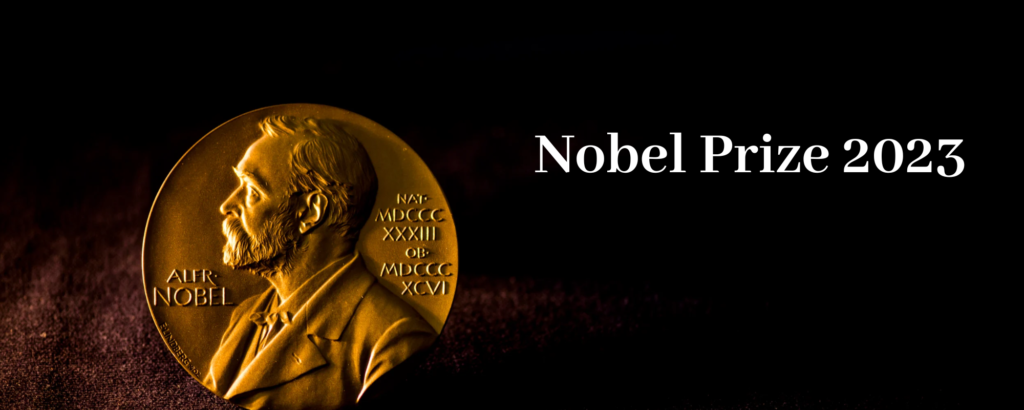Important for
Prelims: Science & Technology
Mains: General Studies

Nobel Prize in physics
- The 2023 Nobel Prize in Physics was awarded to Pierre Agostini, Ferenc Krausz, and Anne L’Huillier for their groundbreaking experiments that have allowed scientists to generate attosecond pulses of light.
- The Nobel was awarded by Royal Swedish Academy of Sciences.
A Problem that had to be solved
- The electron is a subatomic particle with a negative elementary electric charge. Electrons rapid movement made them challenging to study directly.
- Also, to understand why electrons were hard to capture, think of taking a picture of a race car. Longer exposure times result in blurry images, while shorter exposure times yield sharper pictures.
- Electrons move so quickly that capturing them requires extremely short pulses of light such as attosecond.
Attosecond Pulses of Light
- Electron dynamics occur on the attosecond timescale, which is a billionth of a billionth of a second (1×10−18 of a second), much faster than femtoseconds (a millionth of a billionth of a second) associated with atomic movements.
- Until the 1980s, scientists could produce femtosecond pulses, but technology limitations prevented shorter pulses.
- However, studying electrons required even shorter pulses.
Other Applications of Attosecond Pulses
- Atomic and Molecular Imaging
- Material Sciences (matter manipulation at quantum level)
- Electronics and Microprocessors.
- Catalysis of Chemical Reactions.
- Medical Diagnostics.
- Telecommunications.
- Spectroscopy.
Nobel prize in Chemistry
- The 2023 Nobel Prize in Chemistry was awarded for the discovery and synthesis of quantum dots, tiny particles with unique optical properties due to their small size.
- The award was provided by Royal Swedish Academy of Sciences.
What are Quantum Dots ?
- Quantum dots are tiny particles, just a few nanometers in size, with unique optical properties due to their small size.
- While their atomic structure is the same as bulk materials, quantum dots’ properties can be altered by adjusting their size.
- At the nanoscale, these particles exhibit size-dependent characteristics influenced by quantum forces, which differ from macroscopic physics governed by gravity.
Applications of Quantum Dots
- LED Display : Enhance display quality in QLED screens.
- Lighting : Adjust the colour temperature in LED lamps.
- Medical Diagnostics : Map cells and organs for research and diagnostics, like Quantum Dots are used for cancer imaging.
- Targeted Drug Delivery.
- Photovoltaics : Improve solar cell efficiency.
- Quantum Computing.
- Security Applications : Anti-counterfeit markers on currency and documents.
- Quantum Dot Sensors.
Nobel prize in Medicine
- The 2023 Nobel Prize in Physiology or Medicine was awarded to Katalin Karikó and Drew Weissman for their research enabling the development of mRNA vaccines against COVID-19.
- Awarded by the the Nobel Assembly at Karolinska Institutet, Stockholm, Sweden.
- These discoveries, first published in 2005 and further developed in 2008 and 2010, laid the foundation for mRNA vaccine technology.
- Their work not only revolutionized vaccine technology but also has the potential for broader applications in treating diseases and delivering therapeutic proteins.
mRNA Vaccines
- mRNA stands for “messenger RNA.” It is a molecule that carries genetic information from DNA to the ribosomes in cells, where it is used as a template for protein synthesis.
- mRNA vaccines are a type of vaccine that uses messenger RNA (mRNA) to instruct cells in the body to produce a specific viral protein, such as the spike protein of a COVID-19 virus. This protein triggers an immune response, helping the body build immunity against the virus.
- Notably, mRNA vaccines do not contain live or weakened viruses, making them safe and effective tools for preventing infectious diseases like COVID-19.
Important Features of mRNA Vaccines
- Uses RNA as a genetic material.
- mRNA is fragile and generally uses lipid protection.
- It requires ultra low temperatures for storage and transportation.
- Both mRNA and DNA vaccines can be adapted quickly to address emerging variants and new diseases by changing the genetic code.
- Pfizer/BioNTech and Moderna COVID-19 vaccines are mRNA-based.




Leave a Reply
You must be logged in to post a comment.